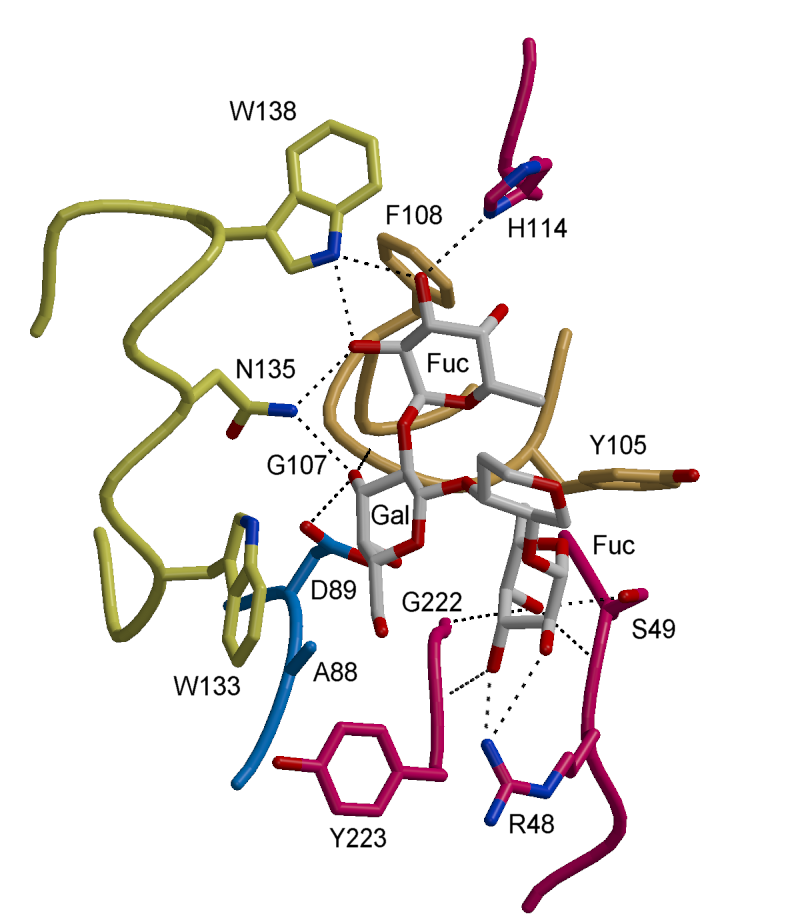Lectin
|
WikiDoc Resources for Lectin |
|
Articles |
|---|
|
Media |
|
Evidence Based Medicine |
|
Clinical Trials |
|
Ongoing Trials on Lectin at Clinical Trials.gov Clinical Trials on Lectin at Google
|
|
Guidelines / Policies / Govt |
|
US National Guidelines Clearinghouse on Lectin
|
|
Books |
|
News |
|
Commentary |
|
Definitions |
|
Patient Resources / Community |
|
Directions to Hospitals Treating Lectin Risk calculators and risk factors for Lectin
|
|
Healthcare Provider Resources |
|
Continuing Medical Education (CME) |
|
International |
|
|
|
Business |
|
Experimental / Informatics |
Lectins are sugar-binding proteins which are highly specific for their sugar moieties. They typically play a role in biological recognition phenomena involving cells and proteins. For example, some bacteria use lectins to attach themselves to the cells of the host organism during infection.

Etymology
The name ‘lectin’ is derived from the Latin word legere, meaning ‘to select’.
History
Although they were first discovered more than 100 years ago in plants, they are now known to be present throughout nature.
It is generally believed that the earliest description of such a hemagglutinin was by Peter Hermann Stillmark in his doctoral thesis presented in 1888 to the University of Dorpat, (one of the oldest universities in czarist Russia). This hemagglutinin, which was also highly toxic, was isolated by Stillmark from seeds of the castor tree (Ricinus communis) and was named ricin.
Biological functions
Most of the lectins are basically non-enzymic in action and non-immune in origin. Lectins occur ubiquitously in nature. They may bind to a soluble carbohydrate or to a carbohydrate moiety which is a part of a glycoprotein or glycolipid. They typically agglutinate certain animal cells and/or precipitate glycoconjugates.

Function in animals
While the function of lectins in plants is believed to be the binding of glycoproteins on the surface of parasitic cells, their role in animals also includes the binding of soluble extracellular and intercellular glycoproteins.
For example, there are lectins found on the surface of mammalian liver cells that specifically recognize galactose residues. It is believed that these cell-surface receptors are responsible for the removal of certain glycoproteins from the circulatory system.
Another example is the mannose-6-phosphate receptor that recognizes hydrolytic enzymes containing this residue and subsequently targets these proteins for delivery to the lysosomes. (one defect in this particular system is known as I-cell disease.)
Lectins serve many different biological functions from the regulation of cell adhesion to glycoprotein synthesis and the control of protein levels in the blood.
Lectins are also known to play important roles in the immune system by recognizing carbohydrates that are found exclusively on pathogens, or that are inaccessible on host cells. Examples are the lectin complement activation pathway and Mannose binding lectin.
Function in plants
The function of lectins in plants is still uncertain. Once thought to be necessary for rhizobia binding, this proposed function was ruled out through lectin-knockout transgene studies.
The large concentration of lectins in plant seeds decreases with growth, and suggests a role in plant germination and perhaps in the seed's survival itself.
Use in science, medicine and technology
Use in medicine and medical research
Purified lectins are important in a clinical setting because they are used for blood typing. Some of the glycolipids and glycoproteins on an individual's red blood cells can be identified by lectins.
- A lectin from Dolichos biflorus is used to identify cells that belong to the A1 blood group.
- A lectin from Ulex europaeus is used to identify the H blood group antigen.
- A lectin from Vicia graminea is used to identify the N blood group antigen.
PHA-L, a lectin from the kidney bean, is used by neuroscientists to trace the path of efferent axons. This usage is called the anterograde labeling method.[1]
Use in studying carbohydrate recognition by proteins
Lectins from legume plants, such as PHA or concanavalin A, have been widely used as model systems to understand the molecular basis of how proteins recognize carbohydrates, because they are relatively easy to obtain and have a wide variety of sugar specificities. The many crystal structures of legume lectins have led to a detailed insight of the atomic interactions between carbohydrates and proteins.
Use in biochemical warfare
One example of the powerful biological attributes of lectins is the biochemical warfare agent ricin. Ricin is isolated from seeds of the castor oil plant and is a protein that comprises two domains,
- One is a lectin that binds cell surface galactosyl residues and enables the protein to enter cells.
- The second domain is an N-glycosidase that cleaves nucleobases from ribosomal RNA resulting in inhibition of protein synthesis and cell death.
See also
References
- ↑ Carlson, Neil R. (2007). Physiology of Behavior, 9th ed. Boston: Pearson Education, Inc. p. 144. ISBN 0-205-46724-5.
- Loris R, Hamelryck T, Bouckaert J, Wyns L (1998). "Legume lectin structure" (PDF). Biochim. Biophys. Acta. 1383 (1): 9–36. PMID 9546043.
- Sharon, N., Lis, H. Lectins, Second Edition (2003) Kluwer Academic
External links
- World of Lectin links maintained by Thorkild C. Bøg-Hansen
- Ni Y, Tizard I (1996). "Lectin-carbohydrate interaction in the immune system". Vet Immunol Immunopathol. 55 (1–3): 205–23. PMID 9014318.
- EY Laboratories, Inc World's largest lectin manufacturer.